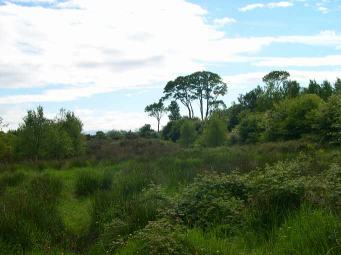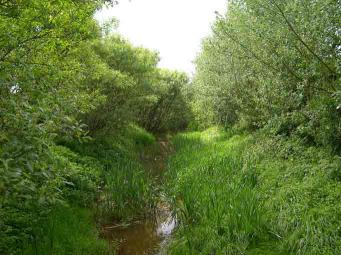Location and Access
Ardeer Quarry (also known as Ardeer Recreational Grounds and Stevenston Park) encompasses a variety of habitats: there are several areas of marshy grassland, a small loch, an even smaller pond, areas of scrub, and a large tree plantation (planted around 1990). Those with a vehicle can park in the small car park at the end of Moorpark Road East. Pedestrian/cycle access can also be had at the other end of the grounds, at the very bottom of Dubbs Road/ Highfield Drive.
 |
 |
A concrete path circles the loch and the Cunninghame Cycleway runs through the area. Walking around the disused playing fields allows closer inspection of the plantation in front of Highfield Drive.
Birds
In summer, the main loch holds Mallard, Moorhen, a pair of Mute Swan, and, in some years, Little Grebe. In winter, these birds are joined by a small flock of Tufted Duck. By the middle of winter, one or two Goldeneye are usually present. Teal visit occasionally, especially during cold weather. Every few weeks a Pochard or a Scaup drops in. Unusual records for the loch include Great Crested Grebe, Red-breasted Merganser, Goosander, Shoveler, Wigeon, and Little Auk. The main loch’s contributory ditch occasionally turns up Water Rail and Kingfisher.
The small pond further east holds breeding Mallard, Moorhen, and Little Grebe. In winter it is largely deserted, save for a few Mallard.
As well as the common tits and finches, the woodland and scrubland hold breeding Bullfinch, Blackcap, Coal Tit, Long-tailed Tit, Goldcrest, Common Whitethroat, Willow Warbler and Chiffchaff. The rough grassland holds several pairs of Reed Bunting, Sedge Warbler, and Grasshopper Warbler.
In winter, Bullfinch can often be found in the trees bordering the cycle path. The Alders often attract large flocks of Siskin and Goldfinch. Small flocks of Long-tailed Tit, Goldcrest, Coal Tit, and Treecreeper are also frequent. Winter thrushes are often encountered. Great Spotted Woodpecker is present throughout the year.
Snipe or Woodcock are regularly flushed – often by straying dogs – from the ditches and damp woodland around the site.
Sparrowhawk and Buzzard, and Kestrel are often seen.
Notes
The best time to visit Ardeer Quarry is during calm, frosty weather in winter. Duck numbers/variety increase slightly, Water Rail can turn up, and tit and finch flocks are relatively easy to locate.
Many birders stop off only briefly at Ardeer Quarry to inspect the birdlife on the main loch, parking in the nearby car park and often setting up their telescopes only a few metres from their car. However, some of the loch’s more unusual wildfowl can often be found behind the island so it is well worth taking the short trip to check this side of the island out.
A short trip along the cycle path from the main loch to where the path crosses the contributory ditch (at NS 274 415) is your best bet if you want to maximise your chances of encountering Water Rail or Kingfisher. Water Rail are particularly fond of the stretch of ditch upstream of the cycle path.
![]() Car park at edge of park. High kerbs. Metalled footpaths, narrow and muddy in places, one steep slope near pond.
Car park at edge of park. High kerbs. Metalled footpaths, narrow and muddy in places, one steep slope near pond.